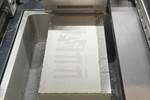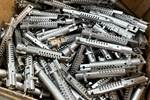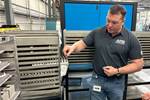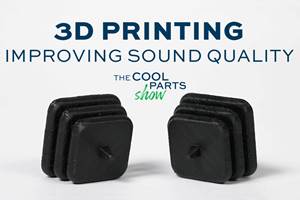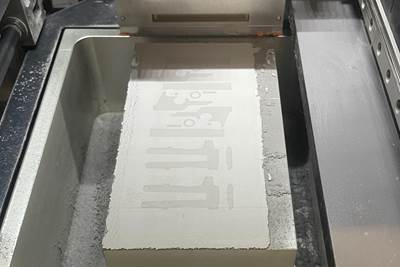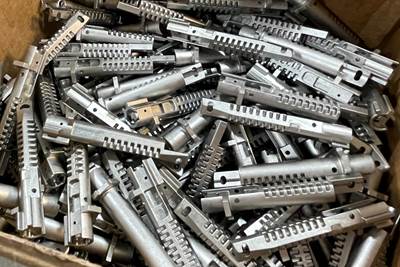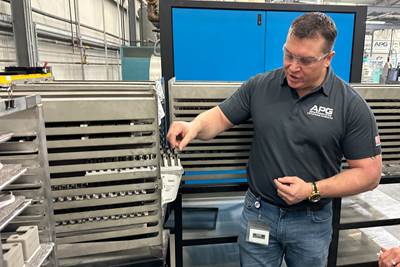3D Printed Capo for Banjo Made With Binder Jetting not MIM: The Cool Parts Show #74
New market, no mold tooling needed: Additive manufacturing via binder jetting enables a maker of guitar capos to expand to serve banjo players as well.
Scroll to unlock this premium content if video does not play.
Paige Musical Products has journeyed through a variety of manufacturing processes to make capos, ultimately landing on metal injection molding (MIM) to produce its Paige Pro capo for guitars. A capo is a tuning accessory for a fretted instrument. When Paige wanted to expand to provide capos to banjo players as well, its journey went farther, because this market size — combined with the variability needed to accommodate banjos — meant mold tooling was not an option. Instead of MIM, Paige produces its banjo capo through binder jetting. We explore that choice in this episode, and we also host our first in-studio banjo player!| This episode of The Cool Parts Show is sponsored by Carpenter Additive
The Cool Parts Show is a video series from Additive Manufacturing Media that explores the what, how and why of unusual 3D printed parts. Watch more here.
Have a cool part to share? Email us.
Related Resources
- Capo maker Paige Musical Products
- Alpha Precision Group’s work in sinter-based additive manufacturing
- The basics of binder jetting
Transcript
Stephanie Hendrixson
Today in the show, we're going to be talking about this accessory for banjo players. It's an assembly with two different integral 3D printed parts.
Peter Zelinski
This is a capo for a banjo. It's developed by Paige Musical Products, which makes these high-end, sophisticated capos for guitar players. And when the company wanted to offer something similar to banjo players, they needed additive manufacturing to get there.
Stephanie Hendrixson
So today we're going to get into how and why the components of this capo are now 3D printed. But first let's talk about what a capo is and what makes this one so special. So a capo is an accessory used by players of stringed instruments, guitars and banjos. Its role is to sort of like hold down the strings to change the pitch of the instrument. And in a lot of cases, the capo is using some sort of like softer material, like a rubber to actually sit against the strings, but with that solution, you don't always get even pressure, even tension across all of the strings. And it can also have some impacts on the sound that you may or may not want. So this capo has a little bit of a different design. So the two pieces that we're going to be talking about today are the yoke and the bar. And if you look at the bar, inside there's this slot with these little plastic inserts. There are four there. There's one for each string. And they sort of self-adjust against the instrument so that you do get even tension across all of the strings. This design was invented by Bryan Paige, who is also the founder of Paige Musical Products.
Bryan Paige, Paige Musical Products
It seems like all of the capos back when we started making capos were just kind of huge. Bigger than they needed to be. Ours are smaller in size. And also, you have total control of the tension. You have a screw that you, you control with your hand, and it's very important to control your tension when you're capoing, because if you have too much tension, you're pulling strings sharp. If you don't have enough tension and you have string buzz.
Peter Zelinski
So you can hear how knowledgeable Bryan is about musical instruments, about fretted instruments. But the business that he started began as a tool and die shop, a machine shop. But Bryan's a musician. He's interested in capos because he felt like he could do it better. And the evolution of his company's capo designs took the company through various manufacturing processes. Capos were made through machining, stamping, die casting, and then with the introduction of the product the company calls the Paige Pro for guitars, they landed on metal injection molding.
Bryan Paige
We wanted it to be stainless steel. It's a really high end product. And, so we went metal injection molding because it's just very intricate, you know, a lot of intricate pieces in it.
Stephanie Hendrixson
So the guitar capo has a very similar design to the one that we have here. Some of those intricacies that Bryan was referring to include the slot in the bar, the latching mechanism, some of the details on the yoke. And those intricacies led Paige Musical Products to metal injection molding, specifically to a company that specializes in powder metallurgy called Alpha Precision Group. Here is Dave Smith, the director of engineering for Alpha Precision Group, or APG.
David Smith, Alpha Precision Group
MIM was a great fit for the six-string assembly and the majority of the components within that assembly because they are relatively small in size, with really complex geometries. So, we were able to form net-shape almost all of the features required for the more complex components. Which, actually, showed a drastic improvement over conventional methods of manufacturing, whether it be machining or, screw machining some of these components. So we offer the value of threads in an as sintered component, as well as significant undercuts that would be really challenging to get with conventional machining methods.
Peter Zelinski
So that's metal injection molding, or MIM, which is kind of like it sounds. It is like injection molding for plastics, the way a lot of plastic parts are made except applied to metal. The starting point is metal powder smushed together into a mold to get the form which is then sintered to finalize the part. It's done on equipment that is just like plastics injection molding. It has many of the same needs, notably the need for a mold, the need for a tool that is just like the part you're trying to produce. And that tool is a big investment. It's expensive. And so if you are going to go to market with a product that's going to be made through metal injection molding, you have to be confident you're going to sell enough units to justify and pay back the cost of that mold tooling. When it was time to introduce the banjo capo, Bryan Paige knew there was a market there, but was there a large enough quantity of potential buyers that he could justify that mold? That was unclear.
Bryan Paige
The problem with the banjo was there's just not the market. There's way more guitar players, right? Than banjo players. You know, I knew about 3D printing, but I had no idea they could do it with metals like 17-4 stainless steel. You know, with the sintering process, you know, kind of like they do the metal injection molding process.
David Smith
So the banjo capo was a new design that incorporated some differences and a lot of upfront design for manufacturing, DFM, considerations. So it led very well to at least prototyping in the metal additive space. In addition to that, until it gains market share, we knew it was going to be lower volume. So not only could we use the metal additive technology to prototype, develop, work through the design with our customer, but also to support the low-volume production until against market share. And we can eventually tool up and metal injection mold it.
Stephanie Hendrixson
So even though APG was already using metal injection molding for the parts of the guitar capo, the quantities needed for the banjo product tipped the scales towards 3D printing. Fortunately, this is also something that APG has experience with. They have a number of different 3D printing technologies that they use, and for the banjo capo they decided to go with metal binder jetting, specifically using the Shop System from Desktop Metal. Similar to metal injection molding, you are building up a green part that you're going to have to sinter later from metal powder. But instead of using a tool or a mold to form the powder, you are developing the green part by literally depositing little droplets of binder across a loose bed of metal powder. Building your part up that way, layer by layer and then extracting it from the powder, de-binding it and sintering it much in the same way that you would with a MIM part.
Peter Zelinski
Binder jetting is a separate process, an additive manufacturing process. It has its own process considerations. APG is knowledgeable about that as well. To talk about that, to talk about the advance of the Paige Pro banjo capo into production through binder jetting, here is APG’s manufacturing engineer for additive manufacturing Joe Taylor.
Joe Taylor, Alpha Precision Group
The starting process is with the design. If the customer does not have a 3D model available, we will have to generate one, then create an STL file. Then that STL file goes into either a build slicing software or into a distortion projecting sintering software that we perform an FEA analysis on to predict sinter distortion. In either one of those softwares, we would create a live setter or, design a live setter. From there, the print file goes into the printer. That's where the printing begins. Then from the printer, we go into a cure oven for a predetermined set time and profile. Then to depowdering to remove all the loose powders around the components. And then into sintering and we have a complete part after that process.
Peter Zelinski
Joe talked about sintering as a necessary part of the binder jetting process. Necessary to metal injection molding too. In binder jetting the 3D printed part bound together in a green state initially, and then it's completed through sintering in a furnace and in that furnace crazy things can happen, do happen. There is shrinkage, for example, but that shrinkage is repeatable. There's the potential for the part to distort, at those high temperatures. But the distortion is predictable and controllable. And this is really a big part of the expertise that APG brings. They are very familiar with sintering from other sinter-based processes that the company has been doing for quite a while. Stephanie, you mentioned how this bar is a particularly intricate part of the capo. Well, actually, in sintering, the challenging part is this yoke because it has these arms that just hang out there kind of suspended in space and, and during sintering those arms can deform. APG sees that coming can predict that control against that. In the case of a challenge like this, the solution is a device in sintering called a live setter.
Joe Taylor
The shrinkage for Desktop Metal’s system is non-isotropic. It could be anywhere from 16 to 20% in X, Y and Z. To mitigate that or to predict that we use a software called live sinter from Desktop Metal that runs an FEA on the part using the STL file and compares it back to the original or native CAD file, and then offsets the printed geometry to get close to that net shape.
David Smith
So once parts were printed, de-powdered and cured, they were also printed with their active setters or their live setters to be able to support that geometry, in preparation for the sintering process. So proactively understanding what distortion is inherent in both processes as a result of high temperature sintering, you know, led us to a place where once we had sintered components, it limited the number of iterations in additive, and reprinting of additive components, to provide acceptable parts that would assemble and function into the final capo assembly.
Stephanie Hendrixson
So, APG needed to control shrinkage and distortion in the sintering of these parts. They were able to do that using some software tools, creating those live setters. Again, these are things that they're pretty used to dealing with on a daily basis. One of the more unique challenges, though, with this capo was the fact that it's a consumer product. This is something that a player is going to use. They're going to touch it, feel it on a daily basis. And so it needs to have good aesthetics. It needs to have a good surface finish. There were some things that APG did in both the printing process and the post-processing, to make sure that this capo was going to look as good as it sounds.
Joe Taylor
Paige Musical is distinctive because this is a visual component. And binder jet yields a semi rough surface finish. Printing orientation and sintering orientation is critical to minimize layer height or layer steps in the Z direction, because these parts are highly polished after sintering. So we have to be cognizant of layer lines and part orientation. So, on Desktop Shop, we have three options for layer height. We can do 100 micron, 75 micron, or 50 micron layer thicknesses. Obviously with the decreased layer thickness, you add cycle time. For this project, we obviously picked the 50-micron layer height and knew what areas of the part were going to be critical and hardest to polish for the end use. So we kind of oriented that where the layer lines would be less pronounced. I will say that there was some postprocessing that was needed on our end for some dimensional requirements. Some coining, some squeezing of features, that we actually learned from our MIM products for the six-string guitar that we utilized in additive.
Bryan Paige
One thing I really liked was the fact that we could get a batch of parts in, and then if we wanted to make a little change next time around, you don't have high tooling cost to do that, you know, so you can kind of, kind of tweak things on the fly. The quantity: You don't have to order thousands of pieces, you know. We've been kind of feeling out the market. And the only thing we've really changed is the bar. You can pretty much change the bar and accommodate for a lot of different instruments by changing the bar radius.
Peter Zelinski
That brings us to one other benefit of using additive manufacturing to produce the banjo capo, which is the variability of banjos from instrument to instrument, specifically the variation in the neck. The front surface of the neck, it might be flat. There might be an arch to it, like a gentle curvature. And the capo has to conform to it. This bar has to match that geometry of the neck. And as it turns out, banjos vary more than guitars do. Paige Musical Products didn't face this problem with its previous capo, but with the banjo capo, this bar needs to vary. Here's another version, and it's hard to see, but there's a little bit of curvature there to match a banjo that has that much curvature, and other banjos could have a different, different radius than this. Trying to serve that need with molds would be impossible. There would be just no way to get a different mold tool for every different curvature of banjo capo bar. But with additive manufacturing, this is no problem. It is easy to serve every possible slight variation in bar that is needed.
Bryan Paige
You have radiuses on banjos from no radius, flat, to like a 7.5-in radius on the fretboard. So the bar needs to match that if you want even pressure. Then when you tighten that down, it tightens all the strings simultaneously, you know, with the same pressure. So banjo players need to match the camber that they're using to their instrument. And there's a relatively high variety of banjos out there for a relatively small number of players. So this is an application with smaller quantities but higher variety. And that means that additive manufacturing, binder jetting, is a better fit for these parts than other processes.
Stephanie Hendrixson
This banjo capo is out there already. It's available and they're already getting some good response. Here's Bryan one more time.
Bryan Paige
The biggest response, we went \ to a kind of a trade show. It's IBMA, an international band competition. There are young musicians that come from all over the United States there. They all seem to have this same banjo lick where they just bend the heck out of the strings. Normally you bend strings with a banjo, and when you have a conventional capo, a lot of times a string will pull sharp underneath the capo. And that was kind of funny, because every musician that would come in there would do the same lick, and they couldn't believe that they could do that lick and the banjo would stay in tune. And it just worked. They couldn't believe the tone that they were getting from it.
Related Content
Sustainable Furniture Company Model No. Maintains Product Focus with Switch from DIY to Industrial 3D Printers
The startup founded in 2018 has matured in its product offerings as well as its manufacturing equipment, moving from homegrown 3D printers to industrial large-format machines.
Read More3D Printing Enables a Larger "Sweet Spot" Relative to This Golf Club's Size: The Cool Parts Show #77
Cobra Puma Golf's Limit3D iron uses 3D printed stainless lattices to remove weight from the interior so that it can be reintroduced with tungsten inserts that lower the center of gravity. The combination offers a smaller, sleeker club head with the forgiveness of a larger one.
Read MoreFizik Utilizes Carbon DLS Technology for One-to-One Program, Creating Customized Bike Saddles
Fizik’s customized bike seat program uses Carbon’s Digital Light Synthesis technology and personalized rider data to create a line of truly custom saddles, giving bike riders the best bike seat for their posterior — only made possible through additive manufacturing.
Read More3D Printed Ductile Spikes for Better Sound Quality: The Cool Parts Show Bonus
Work on 3D printing flexible metal bellows has led to other applications, including the development of ductile spikes that sit between a speaker and the surface below to help limit vibration and isolate the audio equipment.
Read MoreRead Next
AM 101: What Is Binder Jetting? (Includes Video)
Binder jetting requires no support structures, is accurate and repeatable, and is said to eliminate dimensional distortion problems common in some high-heat 3D technologies. Here is a look at how binder jetting works and its benefits for additive manufacturing.
Read MoreBinder Jetting Follows in Footsteps of Metal Injection Molding
For Smith Metal Products, additive manufacturing helps MIM customers finalize the design, but production opportunities are waiting.
Read MoreSinter-Based Additive Manufacturing Finds a Place Alongside MIM, Press and Sinter at APG
Powder metallurgy company Alpha Precision Group (APG) is applying a particular class of metal 3D printing technology for both rapid iteration in development and flexibility in production.
Read More

